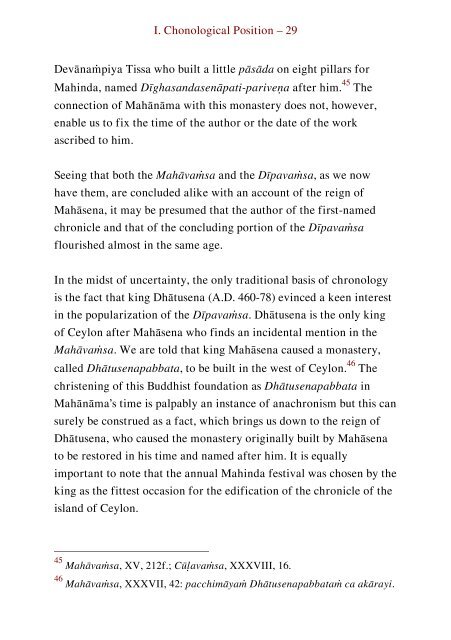On the Chronicles of Ceylon
A judicious appraisal of the various Chronicles that were written in Sri Lanka, assessing their chronology, literary and historical character.
A judicious appraisal of the various Chronicles that were written in Sri Lanka, assessing their chronology, literary and historical character.
- No tags were found...
You also want an ePaper? Increase the reach of your titles
YUMPU automatically turns print PDFs into web optimized ePapers that Google loves.
I. Chonological Position – 29<br />
Devānaṁpiya Tissa who built a little pāsāda on eight pillars for<br />
Mahinda, named Dīghasandasenāpati-pariveṇa after him. 45 The<br />
connection <strong>of</strong> Mahānāma with this monastery does not, however,<br />
enable us to fix <strong>the</strong> time <strong>of</strong> <strong>the</strong> author or <strong>the</strong> date <strong>of</strong> <strong>the</strong> work<br />
ascribed to him.<br />
Seeing that both <strong>the</strong> Mahāvaṁsa and <strong>the</strong> Dīpavaṁsa, as we now<br />
have <strong>the</strong>m, are concluded alike with an account <strong>of</strong> <strong>the</strong> reign <strong>of</strong><br />
Mahāsena, it may be presumed that <strong>the</strong> author <strong>of</strong> <strong>the</strong> first-named<br />
chronicle and that <strong>of</strong> <strong>the</strong> concluding portion <strong>of</strong> <strong>the</strong> Dīpavaṁsa<br />
flourished almost in <strong>the</strong> same age.<br />
In <strong>the</strong> midst <strong>of</strong> uncertainty, <strong>the</strong> only traditional basis <strong>of</strong> chronology<br />
is <strong>the</strong> fact that king Dhātusena (A.D. 460-78) evinced a keen interest<br />
in <strong>the</strong> popularization <strong>of</strong> <strong>the</strong> Dīpavaṁsa. Dhātusena is <strong>the</strong> only king<br />
<strong>of</strong> <strong>Ceylon</strong> after Mahāsena who finds an incidental mention in <strong>the</strong><br />
Mahāvaṁsa. We are told that king Mahāsena caused a monastery,<br />
called Dhātusenapabbata, to be built in <strong>the</strong> west <strong>of</strong> <strong>Ceylon</strong>. 46 The<br />
christening <strong>of</strong> this Buddhist foundation as Dhātusenapabbata in<br />
Mahānāma’s time is palpably an instance <strong>of</strong> anachronism but this can<br />
surely be construed as a fact, which brings us down to <strong>the</strong> reign <strong>of</strong><br />
Dhātusena, who caused <strong>the</strong> monastery originally built by Mahāsena<br />
to be restored in his time and named after him. It is equally<br />
important to note that <strong>the</strong> annual Mahinda festival was chosen by <strong>the</strong><br />
king as <strong>the</strong> fittest occasion for <strong>the</strong> edification <strong>of</strong> <strong>the</strong> chronicle <strong>of</strong> <strong>the</strong><br />
island <strong>of</strong> <strong>Ceylon</strong>.<br />
45 Mahāvaṁsa, XV, 212f.; Cūḷavaṁsa, XXXVIII, 16.<br />
46 Mahāvaṁsa, XXXVII, 42: pacchimāyaṁ Dhātusenapabbataṁ ca akārayi.


















